Cognición y meta-aprendizaje mediante la narración de historias en tecnología educativa
Cognition and meta-learning through storytelling in educational technology
Beatriz Peña-Acuña
Universidad de Huelva
https://orcid.org/0000-0002-0951-795X
Rosario Herrada-Valverde
Universidad de Almería
https://orcid.org/0000-0002-1878-8882
Gabriel Herrada-Valverde
Universidad de Salamanca
https://orcid.org/0000-0002-9275-7515
Agnieszka Andrychowicz-Trojanowska
University of Warsaw
https://orcid.org/0000-0001-6657-8823
RESUMEN
La competencia clave aprender a aprender denota un grado más profundo de aprendizaje personal en comparación con el simple desarrollo de habilidades. Con el objetivo de analizar el desarrollo de la dimensión cognitiva de dicha competencia en el contexto universitario, esta investigación presenta una intervención con storytelling digital en la que participan estudiantes de dos universidades españolas. Haciendo uso del Cuestionario de Evaluación de la Competencia Aprender a Aprender en Estudiantes Universitarios -CECAPEU- y de los datos recopilados de 237 estudiantes a través de cuestionario alojado en Google Forms, se lleva a cabo un estudio cuasi experimental con pruebas inferenciales. Los resultados muestran que la mayoría del alumnado se distribuye entre niveles competenciales medio y alto, y que los alumnos con buen rendimiento académico tienen mejor competencia cognitiva, dependiente más del rendimiento en la asignatura que de la calificación en la Prueba de Evaluación para el Acceso a la Universidad (PEvAU) o de la Formación Profesional (FP). Se concluye que el rendimiento académico en la asignatura a través de intervenciones elaboradas es crucial para el desarrollo de habilidades cognitivas asociadas a la competencia clave aprender a aprender.
PALABRAS CLAVE
Aprender a aprender; habilidades cognitivas; storytelling digital; rendimiento académico; innovación educativa.
ABSTRACT
The key learning-to-learn competence involves a deeper level of personal learning than simple skills development. With the aim of analysing the development of the competence’s cognitive dimension in the university context, this research presents a digital storytelling intervention undertaken with students from two Spanish universities. Using the Evaluation of Learning to Learn Competence in University Students (CECAPEU) Questionnaire and the data collected from 237 students via a Google Forms questionnaire, a quasi-experimental study with inferential tests was carried out. The results show that most students are distributed between the medium and high competence levels, and that students with good academic performance have better cognitive competence, which is more dependent on subject performance than on their score in the Evaluation Test for University Entrance (PEvAU) or Vocational Training (FP). It is therefore concluded that academic performance in the subject through elaborated interventions is crucial for developing cognitive skills associated with the key learning-to-learn competency.
KEYWORDS
Learning to learn; cognitive skills; digital storytelling; academic performance: educational innovation.
1. INTRODUCTION
Learning to learn involves a deeper level of personal learning than mere skills development and it can be fostered through personal growth and academic assessment (Rawson et al., 2000). According to Waeytens et al. (2002), teachers with a broad view of learning to learn implement it differently from those who see it more narrowly, thus influencing their roles, task conception, and instructional approach. Weinstein et al. (2015) pointed out that learning-to-learn strategies, such as active repetition and elaboration, effectively facilitate the acquisition, understanding and application of new knowledge and skills in various performance contexts. According to McConnell-Rogers (2021), teaching-to-learn tasks, such as preparing and presenting dissertations, enhance the students’ conceptual knowledge learning.
Gargallo-López et al. (2020) presented a model in which the learning-to-learn competence was broken down into five dimensions: cognitive, metacognitive, affective-motivational, relational-social and ethical. The first three dimensions come from cognitive psychology and theories on learning strategies and self-regulated learning, the fourth is related to the socio-cognitive approach, and the fifth to the students’ personal and social development. Subsequently, Gargallo-López et al. (2020) presented the so-called Evaluation of Learning-to-Learn Competence in University Students (CECAPEU) Questionnaire, which included these 5 dimensions, 21 subdimensions and 85 items.
Looking at the cognitive dimension, which is the focus of this study, we can see that the original model by Gargallo-López et al. (2020) consists of 5 elements: skills and strategies for effective information management; oral communication skills; written communication skills; skills for using new technologies; and skills for critical and creative thinking. Recent bibliographic studies have given theoretical support to each of these five elements (Rosales-Márquez et al., 2023).
The CECAPEU questionnaire has been applied in different contexts. For instance, Gargallo-López et al. (2023) administered the CECAPEU questionnaire to 396 university students studying Health Sciences with the aim of evaluating the learning-to-learn competence. They concluded that the scores obtained in the cognitive dimension were of medium-high level. In another recent study, Valero & López (2024) administered this questionnaire to a sample of 80 university students on the Degree in Pedagogy course, observing medium-high values for the cognitive competence, and lower values for the relational-social dimension. Becerra-Patiño and Escorcia-Clavijo (2023) gave this questionnaire to a group of 182 higher-education students in the field of sports, resulting in a low cognitive dimension evaluation. Becerra-Patiño et al. (2024) applied the questionnaire to a sample of 23 university students in Sports Sciences to determine the relationships between the learning-to-learn competence, lifestyles and physical fitness. In addition, this questionnaire has been used in non-academic contexts such as the study by Riquelme-Soto et al. (2022), in which 14 employers from different knowledge areas (Health Sciences, Education and Engineering) participated, the results of which showed that the cognitive dimension was the most important.
The present study analyses whether a digital-storytelling intervention has a positive influence on the cognitive dimension. Storytelling consists of conveying narratives through words or experiences to inform or entertain a certain target audience. Digital storytelling (Alanazi, 2018; Quah and Ng, 2022; Scolari et al., 2019) pursues the same objectives by taking advantage of technological tools and digital platforms, so that the storytellers can create interactive and dynamic experiences using various multimedia formats such as text, digital images, audio and video to capture the audience’s attention effectively. In addition to studies focused on educational aspects (González-Zamar et al., 2020; Taveras-Pichardo, 2022; Wu & Chen, 2020), digital storytelling has been applied to contexts such as economics and business education (Nunvarova et al., 2023), environmental education (Sacco et al., 2020), and health (Manohar et al., 2023), as well as to engineering and other STEM subjects (Smyrnaiou et al., 2020; Mou, 2024).
2. MATERIALS AND METHODS
This research is based on a quantitative methodology since the intention is to respond to the hypotheses raised by extracting the regularities of the environment and the causal relationships between the variables within it. This allows one to contrast the hypotheses, describe and compare the results, make generalizations and inferences about the conclusions, and predict future contingencies. For this purpose, a quasi-experimental longitudinal design was created in which the students’ competence level in the cognitive dimension (collected through the CECAPEU questionnaire) was evaluated using pre- and post-treatment measures. The pre-test measure used was the university entrance-exam (PEvAU/FP) scores. The treatment conceived was an intervention for developing the learning-to-learn competence through digital storytelling. Finally, the post-test measure graded the students in this subject. Due to the absence of randomly assigned sample subjects, we established the control variables as the university (Almería, Huelva), the degree (Social Education, Early Childhood Education and Primary Education), the incidental group, and the student’s sex.
Based on this design, the following aspects were analysed:
•Whether students with good academic performance in relation to their PEvAU /FP grade (the pre-test) obtained a higher competence level in the cognitive dimension, or in some variables of the cognitive dimension.
•Whether students with good academic performance in relation to their final subject grade obtained a higher competence level in the cognitive dimension, or in some variables of the cognitive dimension.
•Whether, after the digital storytelling intervention, the participants who had good performance in the subject had progressed in the cognitive dimension, or in some of the variables of the cognitive dimension, considering a longitudinal estimation.
2.1. Hypotheses
Based on the research objectives, three hypotheses were posited:
•First hypothesis (H1):
H1 (null). The students’ competency levels with respect to learning to learn did not reach the medium-high level.
H1 (alternative) The students’ competency levels with respect to learning to learn reached the medium-high level.
•Second hypothesis (H2):
H2 (null): Academic performance in PEvAU/FP is related to a higher competency level in the cognitive dimension or its variables.
H2 (alternative) Academic performance in PEvAU/FP is not necessarily related to a higher proficiency level in the cognitive dimension or its variables.
•Third hypothesis (H3):
H3 (null). Students with good academic performance in the subject (their final grade) do not tend to show higher cognitive competence.
H3 (alternative). Students with good academic performance in the subject (their final grade) tend to show greater cognitive competence.
2.2. Participants
The sample consisted of 237 students belonging to four groups, two from the University of Huelva (UHU) and two from the University of Almería (UAL). As Table 1 shows, 128 students (54 %) were from UHU and 109 (46 %) from UAL.
|
Sample (n=237) |
Course/Degree |
Subject |
University |
|---|---|---|---|
|
84 |
2nd Primary Ed. |
Didactics of oral and written language |
UHU |
|
44 |
2nd Early Childhood Ed. |
Didactics of oral and written language |
UHU |
|
58 |
2nd Social Ed. |
Continuing education |
UAL |
|
51 |
1st Social Ed. |
Sociocultural foundations of social education |
UAL |
Regarding gender, it should be noted that 33 of the 237 participants in the study (13.9 %) were men while 204 were women (86.1 %). The percentages between the two universities were similar (13/87 % at UAL and 14.7/85.3 % at UHU).
In terms of age, all the students were under 30 years of age, with 90 % of the students in the 18-24 age group, while only 10 % were between 25 and 30 years of age.
2.3. Instruments
The instrument used to assess the learning-to-learn competency was the validated CECAPEU questionnaire in Spanish (Gargallo-López et al., 2021). This extensive questionnaire is described below. It contains a total of 85 items that include 5 dimensions/scales: Cognitive, Metacognitive, Affective and Motivational, Relational-Social, and Ethical. The questionnaire is reproduced in full in the work’s annex ( ).
As previously indicated, this research focuses on the cognitive dimension, so the only items analysed are those linked to it (items 1 to 33). These items are grouped into 4 first-level subdimensions/subscales: information management (items 1 to 19); communication skills (items 20 to 26); ICT management (items 27 to 29) and critical and creative thinking (items 30 to 33). In turn, the “information management” subscale is subdivided into several 2nd-level subscales (information search; attention in class; note-taking; making connections between what is being learned and what has already been learned; elaborating and organizing information; comprehensive memorization; information retrieval; and organizing information for its retrieval in exams and papers). Likewise, the “communication skills” subscale is subdivided into two 2nd-level subscales (oral expression and communication skills; and foreign language skills).
The questionnaire used a Likert scale where: 1=strongly disagree; 2=disagree; 3=undecided; 4=agree; and 5=strongly agree. This makes it possible to define different competence levels based on the following criteria:
•High Competence Level: an average score between 4 and 5.
•Medium Competence Level: an average score between 3 and 3.9.
•Low Competence Level: an average score between 2 and 2.9.
•Very Low Competence Level: an average score between 1 and 1.9.
The questionnaire also includes identifying questions (such as gender) and academic data (university and degree) linked to the control variables, and questions associated with the academic grades obtained before (the PEvAU/FP grade) and after the treatment (the subject grade in which the treatment is framed), which were taken as pre-test and post-test measures, respectively.
2.4. Procedure
The 12-week intervention phase was structured as described in Figure 1. In the first stage (lasting 3 weeks), an inquiry was proposed on a relevant social issue. In the second stage (lasting 2 weeks), an original script was created and structured by the teams, the aim being to disseminate and raise awareness of this issue, based on the information gathered. In the third stage (lasting 6 weeks), the teams produced a video using specialized ICT tools. The fourth stage (the final week) consisted of the teams giving an oral presentation of the work and creating a video. After the intervention, data collection was carried out using a Google Forms questionnaire that was accessed individually in Moodle on a consensual and voluntary basis.
Figure 1. Intervention phases.

2.5. Data analysis
For the quantitative evaluation, the Chi-square test of independence was used for the ordinal data, and the one-factor analysis of variance (ANOVA) test for the scalar data. Accordingly, the homoscedasticity assumption was tested by means of Levene’s test (assuming equal variances) and the effect size value was measured using Kendall’s Tau-b (3x3 tables) or Kendall’s Tau-c (3x4 tables) for the Chi-square test, as well as partial E-squared for the analysis of variance (ANOVA) test. In addition, contingency tables containing the Chi-square and Tukey post-hoc with ANOVA were used for further analysis.
IBM SPSS Statistics 28 software was used for the data analysis. The data matrix constructed made it possible to evaluate the sample subjects according to the established variables based on the statistics used. To undertake the Chi-square test, the PEvAU/FP grades and the subject grades were categorized to establish a longitudinal study of the grade evolution, setting a low performance pass between 5.00 and 6.9, a medium performance pass (for those with good grades) between 7.0 and 8.9, and a high performance pass (for those with outstanding grades) between 9.0 and 10.0.
3. RESULTS
Before analysing the results of the quantitative evaluation itself, it should be noted that, as shown in Table 2, no statistically significant differences were observed in the cognitive dimension and its respective subdimensions (p >.05) as a function of the control variables university, degree, incidental group, or sex.
Table 2. Tests of independence (𝓧2) for the cognitive dimension control variables.
|
Control variables |
𝓧2 (gl) |
p |
Cramer’s V |
|---|---|---|---|
|
University |
3.121 (3) |
.373 |
.197 |
|
Degree |
10.356 (6) |
.110 |
.110 |
|
Incidental Group |
14.626 (9) |
.102 |
.102 |
|
Sex |
1.663 (2) |
.435 |
.435 |
The results associated with the pre-test measure indicated no statistically significant differences in the cognitive dimension as a function of the performance obtained in PEvAU/FP: 𝓧2 (6, N=237) = 6.41, p =.170, τB =.15. Figure 2 shows that, regardless of the PEvAU/FP performance, most of the students are distributed between the medium and high proficiency levels. It should be noted, however, that students who obtained a medium or high performance in PEvAU/FP were placed in a high competence level to a greater extent than those who obtained a low competence level in PEvAU/FP, whereas students who obtained a low or medium performance in PEvAU/FP were placed in a medium competence level to a greater extent than those who obtained a high performance in PEvAU/FP.
Figure 2. Cognitive dimension proficiency level vs. PEvAU/FP performance (pre-test measure).
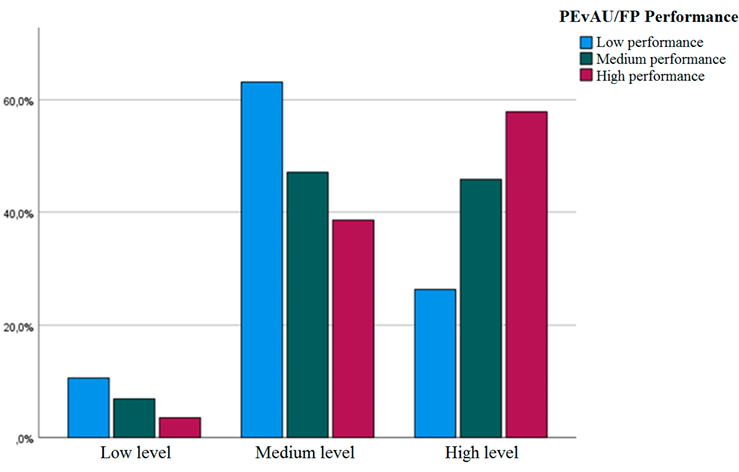
Admitting the absence of intergroup differences in this dimension, one needs to mention that statistically significant differences exist according to the PEvAU/FP performance in some first-level subdimensions (“effective information management”; “critical and creative thinking”) and second-level subdimensions (“attention in class; note-taking”; ‘ making connections between what is being learned and what has already been learned’) of the cognitive dimension.
Beginning with the subdimension “making connections between what is being learned and what has already been learned”, statistically significant differences were found: 𝓧2 (6, N=237) = 10.15, p =.038, corresponding to a weak effect size, τB =.18. Figure 3 reflects that, although all the groups were mostly situated at a high proficiency level, as PEvAU/FP performance increased, a higher percentage of students appeared at the high proficiency level. On the other hand, a higher percentage of students with low PEvAU/FP performance were found at the medium and low proficiency levels.
Figure 3. Proficiency level in the subdimension “Making connections between what is being learned and what has already been learned” (pre-test measure).

Regarding the first-level subdimension “Effective information management”, there were intergroup differences according to the PEvAU/FP performance: 𝓧2 (6, N=237) = 10.79, p =.003, which would correspond to a weak effect size, τc =.12. Figure 4 shows that most of the students who had a medium PEvAU/FP performance had a high (50.9 %) or medium (44.1 %) level of competence. On the other hand, the group with a low PEvAU/FP performance had, for the most part, a medium level of competency (63.2 %). Finally, most of the group with a high PEvAU/FP performance had a high level of competency (64.9 %).
Figure 4. Level of proficiency in the subdimension “Effective Information Management” (pre-test measure).

The first-level subdimension “Critical and creative thinking” also showed statistically significant differences as a function of the PEvAU/FP performance: 𝓧2 (6, N=237) = 18.16, p =.006, corresponding to a weak effect size, τc =.11.
Figure 5. Proficiency level in the subdimension “Critical and Creative Thinking” (pre-test measure).

Figure 5 shows that, although most students obtained a high proficiency level, there are certain intergroup differences. First, a high percentage of students with high PEvAU/FP performance had a high proficiency level (75.4 %). Secondly, most of the students who had a very low competency level were concentrated in the group with a low PEvAU/FP performance (5.3 %). Finally, there was a lower percentage of students with a high PEvAU/FP performance who had a medium proficiency level (17.5 %) than students who had a similar level in the other two groups.
Based on the results discussed for the first- and second-level subdimensions, it might appear that, the higher the students’ PEvAU/FP performance (medium and/or high), the better their level of competency. However, the Tau-b and Tau-c indicators showed a weak effect size, so the relationship between variables would be small. If we add to this the fact that there were no statistically significant differences in the cognitive dimension, nor in most of the subdimensions associated with it, there does not seem to be a close relationship between good academic performance in the PEvAU/FP and obtaining a higher level of competence in the Cognitive dimension, or in some variables of it.
In contrast to the pre-test measure, the post-test measure overall reflected significant differences in the cognitive dimension as a function of the performance obtained in the subject: 𝓧2 (6, N=237) = 108.22, p = <.001, which corresponded to a strong effect size, τB =.60 (see Figure 6).
Figure 6. Competence level in the Cognitive Dimension (post-test measure).
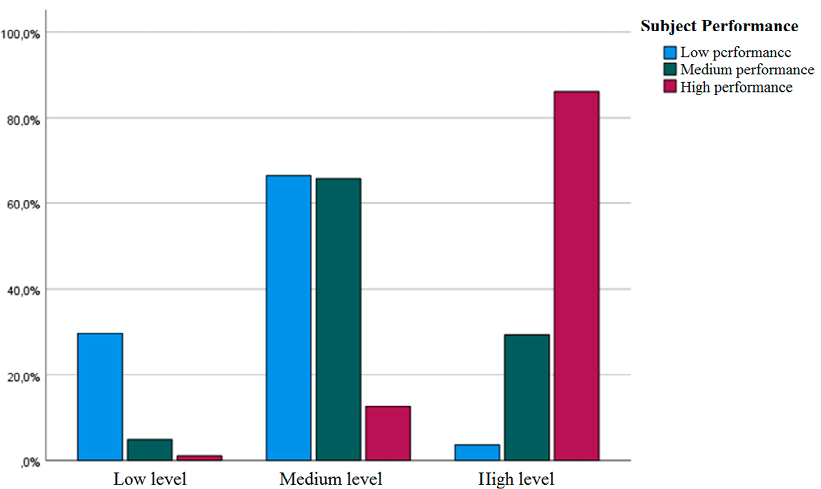
Statistically significant differences with a strong effect size were observed the second-level subdimension “Information search and selection” (see Figure 7): 𝓧2 (6, N=237) = 120.72, p = <.001, τB =.60; and the first-level subdimension “Information management” (see Figure 8): 𝓧2 (6, N=237) = 123.47, p = <.001, τc =.57.
Figure 7. Proficiency level in the subdimension “Information Search and Selection” (post-test measure).
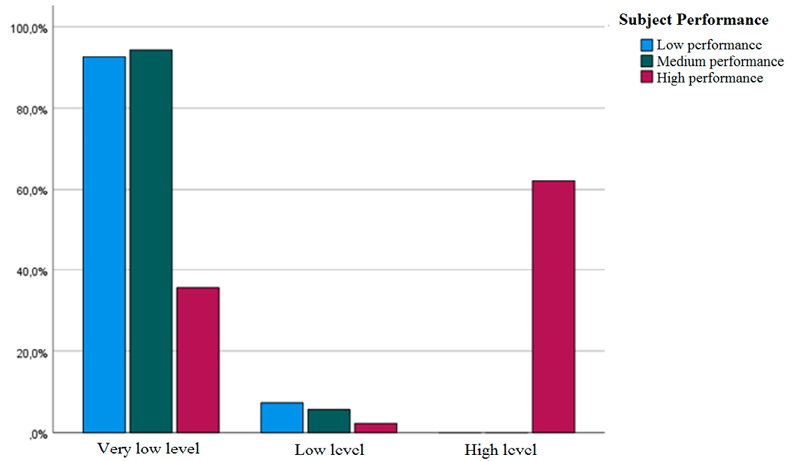
Figure 8. Proficiency level in the subdimension “Effective Information Management” (post-test measure).
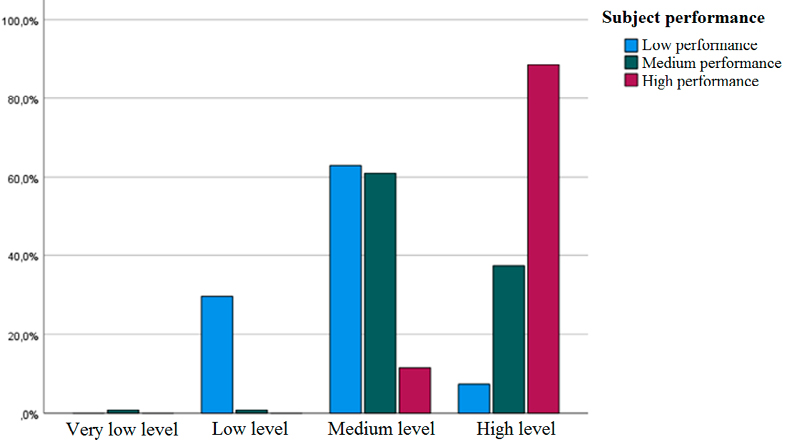
On the other hand, moderate effect sizes were observed in the second-level subdimensions “Comprehensive Memorization” (Figure 9): 𝓧2 (6, N=237) = 68.16, p = <.001, τc =.39; “Organizing information for retrieval in tests and papers” (Figure 10): 𝓧2 (6, N=237) = 78.98, p = <.001, τc =.41; and the first-level subdimension “Communication Skills” (Figure 11): 𝓧2 (6, N=237) = 81.59, p = <.001, τc =.44.
Figure 9. Proficiency level in the subdimension “Comprehensive Memorization” (post-test measure).
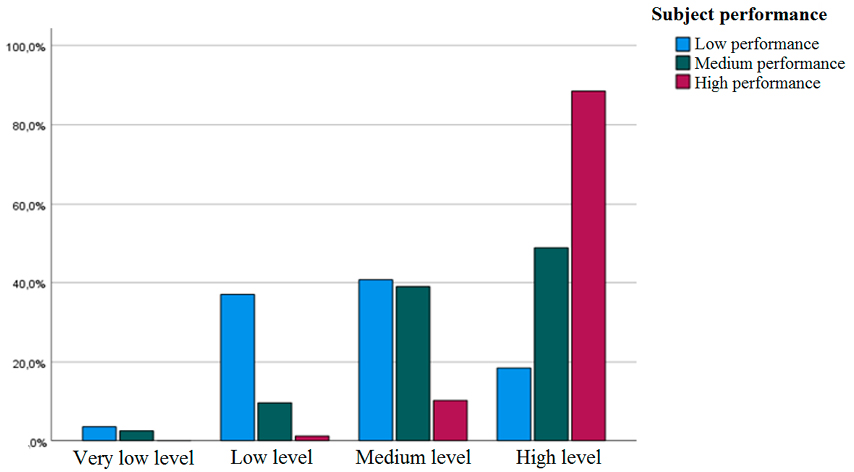
Figure 10. Proficiency level in the subdimension “Organizing information retrieval for exams and papers” (post-test measure).
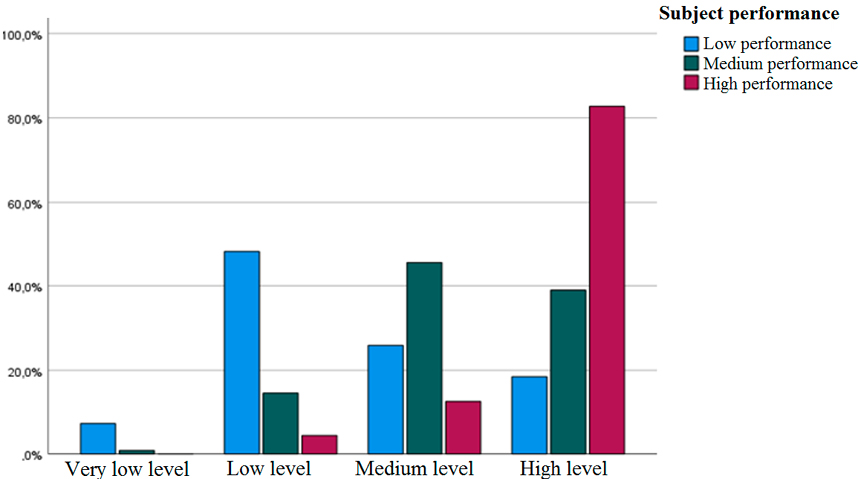
Figure 11. Competence level in Communication Skills (post-test measure).
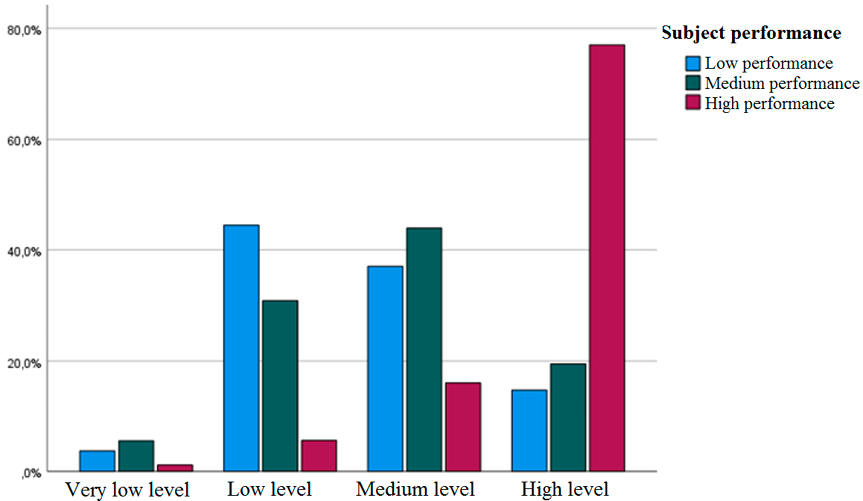
Based on the results obtained from this post-test measure, we can conclude that students with good academic performance in the subject (their final grade) obtained a better competence level in the Cognitive Dimension, or in some variables of it.
In general, there is a closer link between the performance obtained in the subject and the students’ level of cognitive dimension competence than between the performance obtained in the PEvAU/FP and this level of competence. Firstly, students who had a high subject performance had a much higher percentage of high-level competence in the cognitive dimension than those with a high PEvAU/FP performance (86.2 % for the former and 57.9 % for the latter). Secondly, there was a higher percentage of low and medium PEvAU/FP students who obtained a high competence level in the cognitive dimension (26.3 % and 46 %, respectively) than low and medium PEvAU/FP students who did the same (3.7 % and 29.3 %, respectively); it was observed that there was a considerable number of students who had a low or medium PEvAU/FP performance and obtained a high PEvAU/FP performance in the subject. Third, there was a higher percentage of students with low subject performance who had a low competence level (29.6 %) than students with a low PEvAU/FP performance who had a low competence level (10.5 %); it was also observed that some students with a high or medium PEvAU/FP performance obtained a low subject performance. In fact, the relationship between having a good PEvAU/FP performance and obtaining good subject performance (see Figure 12) was small if we consider that there were statistically significant differences: 𝓧2 (6, N=237) = 19.52, p = <.001, which corresponded to a weak effect size, τB =.22.
Figure 12. Performance levels.
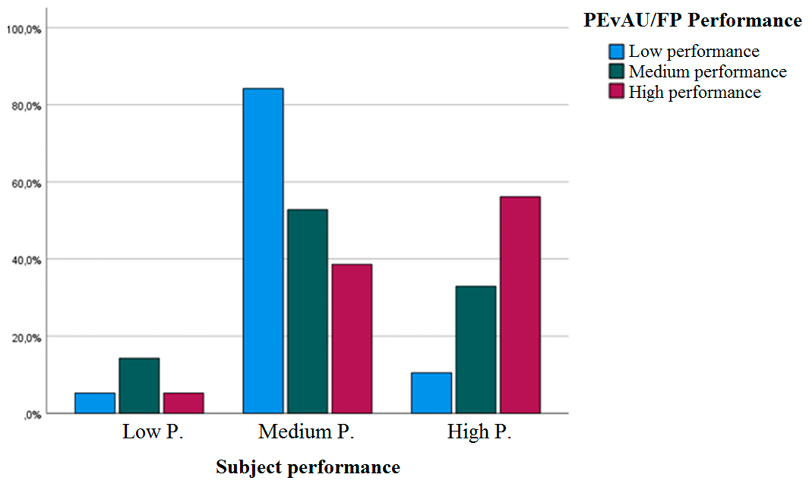
Based on the results of the Chi-square tests, a one-factor analysis of variance (ANOVA) was performed to verify (using scalar data) the relationship found between the subject performance and the competence level in the cognitive dimension. For this purpose, some descriptive statistics were first defined (see Table 3) and then Levene’s test was applied, F (2, 234) =.091, p =.913.
Table 3. Descriptive data on the interaction between subject performance and the competence level in the cognitive dimension.
|
Descriptive statistics |
||||
|---|---|---|---|---|
|
Mean |
Std. Dev. |
Confidence Interval 95 % |
||
|
Competence level |
Low |
104.14 |
10.33 |
[100.05, 108.23] |
|
Medium |
126.77 |
10.20 |
[124.95, 128.59] |
|
|
High |
154.81 |
10.29 |
[152.62, 157.01] |
|
Given that the homoscedasticity assumption was met, the analysis of variance was performed. This test verified the existence of statistically significant intergroup differences as a function of subject performance for the cognitive dimension, F (2, 234) = 324.12, p = <.001, associated with a strong effect size, ηp² =.735. Specifically, 73.5 % of the dependent variable’s (the cognitive dimension) variability was explained by the independent variable’s variability (the subject performance). More specifically, the Tukey post-hoc indicated the existence of significant differences between the different performance levels, and especially between high performance and medium and low performance (see Table 4).
Table 4. Mean differences according to subject performance for the cognitive dimension.
|
TUKEY |
|||
|---|---|---|---|
|
Mean difference |
p |
||
|
Low Performance |
Medium P. |
–22.62421* |
<.001 |
|
High P. |
–50.66794* |
<.001 |
|
|
Medium Performance |
Low P. |
22.62421* |
<.001 |
|
High P. |
–28.04373* |
<.001 |
|
|
High Performance |
Low P. |
50.66794* |
<.001 |
|
Medium P. |
–28.04373* |
<.001 |
|
* Mean difference is significant at the.05 level.
The results of the one-factor analysis of variance test (ANOVA) confirmed the Chi-square tests: the higher the subject performance, the higher the competence level in both dimensions and, therefore, the greater the effectiveness of the treatment. In fact, the post-hoc Tukey test showed significant differences between all the groups that included the independent variable - subject performance - in relation to the competence level obtained in the cognitive dimension.
4. DISCUSSION
The present research analysed the cognitive dimension of the learning-to-learn competency using the CECAPEU questionnaire (Gargallo-López et al., 2021) after carrying out an intervention based on digital storytelling over a four-month period, in which 237 students on different Education degrees from two Spanish universities participated. As is commented on below, the conclusions obtained from the collected data are of great interest and, to a large extent, consistent with recent research findings on the development of this competence.
First, it is important to mention that there are various studies showing that, for a cognitive-strategy teaching program to be internalized in a meaningful way by the students, it is not enough to carry out workshops isolated from the academic curriculum or specific tasks within specific subjects. In this regard, the work by Wibrowski et al. (2017) indicates that when cognitive-strategy teaching programs are offered independently of academic content, students are often unable to apply the strategies within the framework of academic tasks. In turn, studies such as the one by Biwer et al. (2020) or by McDaniel and Einstein (2020) show that students often find it difficult when they learn the strategies within a specific discipline in which they perform a particular task, after which they have to use them across different tasks within the same discipline over the entire course (or term), or when they must apply them to other disciplines. According to Carpenter et al. (2020), Deslauriers et al. (2019), and Trninic et al. (2022), one of the problems encountered by teachers when teaching cognitive strategies is that students prefer to attend well-organized and structured lectures without actively engaging with the material, rather than performing tasks that require them to apply new concepts as they learn them. According to these authors, students perceive the use of cognitive strategies as unnecessary effort that requires them to invest a large amount of cognitive resources, since they do not understand the relevance of this investment for learning purposes. Taking this as a reference, Ploran et al. (2023) and Winkelmes et al. (2019) conducted studies on the importance of developing a transparent design, which encourages continuous feedback, favours the completion of tasks situated in the real world, and explains the importance of using cognitive and metacognitive strategies to improve the learning process, while recognizing the value of desirable difficulties. This research showed that students who take a course focused on acquiring cognitive and metacognitive strategies and that has a transparent design maintained more stable effort levels and felt more control over their learning than students in the control group. This is consistent with the design established in the present study when implementing the treatment for developing the learning-to-learn competence. Specifically, the use of digital storytelling motivated students to recognize the value of desirable difficulties as a necessary component for effective education (Corchuelo et al., 2020), encouraged the completion of tasks linked to the real world, and facilitated continuous feedback from the researchers, allowing most students to reach the medium-high level of competence in learning to learn, thus fulfilling the alternative H1.
Secondly, it is important to note that different authors, such as Pérez-Pérez et al. (2020), state that university students maintain the perception common in previous educational stages that learning is equivalent to reproducing knowledge and, therefore, consider the strategies they can acquire in a program as isolated from the content of the different degree subjects or inserted in a specific task within a subject to be of little or no use. This is consistent with the results of the pre-test phase of the study presented in this article, which indicates that a better PEvAU/FP score (a measure associated with pre-university stages) has little or no relationship with a better performance level in the cognitive dimension. In fact, having a good PEvAU/FP performance did not guarantee a good grade in the subject within which the intervention was carried out. In other words, alternative H2 is fulfilled.
Third, the results of the post-test measure (the subject grade) are closely linked to the development of cognitive competence, reflecting the treatment’s effectiveness (an intervention involving digital storytelling), given that the established control variables did not show significant intergroup differences and that the treatment was framed within the subject. These results, which confirm alternative H3, suggest that, by developing appropriate activities and strategies, students can be encouraged to improve their academic performance, which in turn promotes the acquisition of key cognitive skills and improves long-term learning.
5. CONCLUSIONS
Based on the above, it can be concluded that digital storytelling, as an innovative pedagogical strategy, has a significant impact on the scientific and educational community by promoting active and autonomous learning. The results show improvements in academic performance and in the development of key cognitive skills, which reinforces its methodological value in the university environment. Furthermore, in terms of how university professors can apply it in practice, we can state that when teaching the learning-to-learn competence, it should be integrated within the university disciplines based on a transparent design oriented to performing tasks in real contexts, offering continuous feedback from these educational agents.
The teacher’s role is fundamental in guiding and accompanying these technological interventions, although limitations may include a lack of technical training or resistance to change. For this reason, it would be advisable to improve teacher training so that teachers can efficiently apply this methodology.
Certain study limitations should be pointed out. Firstly, this work could have been complemented by qualitative research using focus groups combined with participant observation. Likewise, a pretest-posttest experimental study could have been designed to include experimental and control groups. The sample could also have been widened to include groups of undergraduate education students from other universities. Qualitative research incorporating discussion groups and participant observation, linked to the components of this quantitative study, still needs to be carried out prospectively in order to look more deeply at the aspects developed in this research. On the other hand, it is worth mentioning that various studies have recently suggested that it could be beneficial to consider the impact of different learning styles on the effectiveness of narrative videos (Ginting et al., 2024), an aspect that could also be addressed in future research.
DATA ACCESSIBILITY STATEMENT
The data supporting the results presented in this study are available from the Zenodo repository [https://zenodo.org/records/14012782]. While the dataset is publicly accessible, users are required to contact the corresponding author.
STATEMENT OF ETHICS
Informed written consent was secured from all participants, adhering to the ethical standards of the Declaration of Helsinki.
AUTHORS’ CONTRIBUTIONS
Beatriz Peña-Acuña: conceptualization; data management; formal analysis; obtaining funding; research; methodology; project management; resources; supervision; writing functions - original draft; writing - revision and editing. Rosario I. Herrada: conceptualization; data curation; research; methodology; validation; visualization; writing functions - original draft; writing - review and editing. Gabriel Herrada-Valverde: conceptualization; data management; data curation; formal analysis; research; methodology; software; validation; writing functions - original draft; writing - review and editing. Agnieszka Andrychowicz-Trojanowska conceptualization; research; methodology; validation; visualization; writing functions - original draft; writing - review and editing.
FUNDING
This work is part of the R+D+i project “Multiliteracies for adult at-risk learners of additional languages (MultiLits)”, REF. PID2020-113460RB-I00, financed by MCIN/AEI/10.13039/501100011033/. Likewise, this work is part of the Innovation Project REF. 23_24_1_41, financed by the University of Almería.
REFERENCES
(2018). The Impact of storytelling to enhance thinking skills of primary school students: A contextual study of Saudi Arabia. IJERI: International Journal of Educational Research and Innovation, (10), 1–26. https://www.upo.es/revistas/index.php/IJERI/article/view/2979
, & (2023). Evaluación de la competencia aprender a aprender en estudiantes universitarios colombianos de Licenciatura en Deporte: estudio exploratorio. Retos, 48, 1019-1030. https://doi.org/10.47197/retos.v48.97412
, , , , , , , , & (2024). Relación de la competencia aprender a aprender, estilos de vida y condición física en estudiantes universitarios colombianos de deporte: Estudio exploratorio. Retos, 51, 58–68. https://doi.org/10.47197/retos.v51.100442
, , , & (2020). Fostering effective learning strategies in higher education – A mixed-methods study. Journal of Applied Research in Memory and Cognition, 9(2), 186–203. https://doi.org/10.1016/j.jarmac.2020.03.004
, , & (2020). On students’(mis) judgments of learning and teaching effectiveness. Journal of Applied Research in Memory and Cognition, 9 (2), 137–151. https://doi.org/10.1016/j.jarmac.2020.04.003
, , , & (2020). Creación y análisis de un repositorio videográfico educativo para la sensibilización de problemas sociales en la educación superior. Formación Universitaria, 13, 5, 103-114. https:/doi.org/10.4067/S0718-50062020000500103
, , , , & (2019). Measuring actual learning versus feeling of learning in response to being actively engaged in the classroom. PNAS Proceedings of the National Academy of Sciences, 116(39), 19251–19257. https://doi.org/10.1073/pnas.1821936116
, , , y (2020). La competencia aprender a aprender: valoración de un modelo teórico | The learning to learn competence: An assessment of a theoretical model. Revista Española de Pedagogía, 78(276), 187-211. https://doi.org/10.22550/REP78-2-2020-05
, , , , & (2021). El cuestionario CECAPEU. Un instrumento para evaluar la competencia aprender a aprender en estudiantes universitarios. RELIEVE. Revista Electrónica de Investigación y Evaluación Educativa, 27(1), art. 1. http://doi.org/10.30827/relieve.v27i1.20760
, , , , & (2023). La competencia aprender a aprender y su relación con el rendimiento académico en alumnado de ciencias de la salud. Revista Española de Orientación y Psicopedagogía, 34(2), 126-148. https://doi.org/10.5944/reop.vol.34.num.2.2023.38070
, , , , , & (2024). The Effects of Digital Storytelling on the Retention and Transferability of Student Knowledge. SAGE Open, 14(3). https://doi.org/10.1177/215824402412712
; , & (2020). Digital Education and Artistic-Visual Learning in Flexible University Environments: Research Analysis. Education Sciences, 10, 294. https://doi.org/10.3390/educsci10110294
, , & (2023). Evaluating an intergenerational art and storytelling program with older adults and medical students. International Review of Psychiatry, 35(7-8), 608-618. https://doi.org/10.1080/09540261.2023.2278717
(2021). Teaching-to-Learn. International Journal of Innovative Teaching and Learning in Higher Education, 2(1), 1-14. https://doi.org/10.4018/ijitlhe.289863.
, & (2020). Training learning strategies to promote self-regulation and transfer: The knowledge, belief, commitment, and planning framework. Perspectives on Psychological Science, 15(6), 1363–1381. https://doi.org/10.1177/1745691620920723
(2024). The practice of visual storytelling in STEM: Influence of creative thinking training on design students’ creative self-efficacy and motivation. Thinking Skills and Creativity, 51, 101459. https://doi.org/10.1016/j.tsc.2023.101459
, , & (2023). Digital storytelling in economics subjects and its effectiveness on student learning outcomes by gender and different economic knowledge. Journal on Efficiency and Responsibility in Education and Science, 16(3), 208-219. https://doi.org/10.7160/eriesj.2023.160305
, , , , & (2020). La competencia aprender a aprender en grados universitarios. Aula Abierta, 49(3), 309-323. https://doi.org/10.17811/rifie.49.3.2020.309-323
, , , , , & (2023). Learning to learn: A pilot study on explicit strategy instructions to incoming college students. Acta Psychologica, 232, 103815. https://doi.org/10.1016/j.actpsy.2022.103815
, & (2022). A systematic literature review on digital storytelling authoring tool in education: January 2010 to January 2020. International Journal of Human–Computer Interaction, 38(9), 851-867. https://doi.org/10.1080/10447318.2021.1972608
(2000). Learning to Learn: More than a skill set. Studies in Higher Education, 25, 225 - 238. https://doi.org/10.1080/713696137
, , y (2022). La competencia aprender a aprender en la universidad. La perspectiva de los empleadores. REDU. Revista de Docencia Universitaria, 20(2), 9-30. https://doi.org/10.4995/redu.2022.16572
, , , & (2023). Aprendizaje autorregulado para aprender a aprender en la formación universitaria. Human Review. International Humanities Review/Revista Internacional de Humanidades, 21(2), 269-281. https://doi.org/10.37467/revhuman.v21.5058
, , & (2020). Developing European key competences with green education. European Journal of Sustainable Development, 9(3), 324-324. https://doi.org/10.14207/ejsd.2020.v9n3p324
, , & (2020). Promoting a mixed-design model of scientific creativity through digital storytelling—the CCQ model for creativity. International Journal of STEM Education, 7, 1-22. https://doi.org/10.1186/s40594-020-00223-6
, , & (2019). Educación Transmedia. De los contenidos generados por los usuarios a los contenidos generados por los estudiantes. Revista Latina De Comunicación Social, (74), 116–132. https://doi.org/10.4185/RLCS-2019-1324
(2022). Cognitive and affective variables predictive of the academic performance of university students. IJERI: International Journal of Educational Research and Innovation, (18), 118–131. https://doi.org/10.46661/ijeri.6189
, , & (2022). Comparing the effectiveness of preparatory activities that help undergraduate students learn from instruction. Learning and Instruction, 82, 101688. https://doi.org/10.1016/j.learninstruc.2022.101688
, & (2024). Habilidades emocionales para el desarrollo de la competencia aprender a aprender (AaA). Revista d’Innovació Docent Universitària, 16, 25-35. https://doi.org/10.1344/RIDU2024.16.3
, , & (2002). ‘Learning to learn’: teachers’ conceptions of their supporting role. Learning and Instruction, 12, 305-322. https://doi.org/10.1016/S0959-4752(01)00024-X
, , , , , & (2015). Learning to Learn, International Encyclopedia of the Social & Behavioral Sciences (Second Edition, 712-719. https://doi.org/10.1016/B978-0-08-097086-8.92037-3
, , & (2017). The role of a skills learning support program on first-generation college students’ self-regulation, motivation, and academic achievement: A longitudinal study. Journal of College Student Retention: Research, Theory & Practice, 19(3), 317–332. https://doi.org/10.1177/1521025116629
, , & (2019). Transparent design in higher education teaching and leadership. Sterling, VA: Stylus Publishing.
, & (2020). A systematic review of educational digital storytelling. Computers & Education, 147, 103786. https://doi.org/10.1016/j.compedu.2019.103786